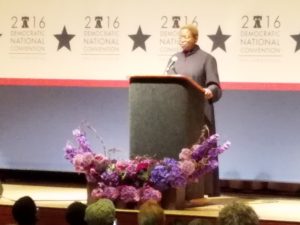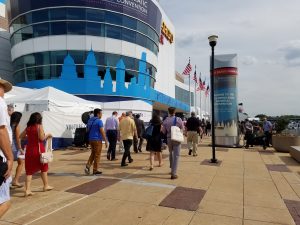People who know me credit me with a few talents – but musical ability isn’t one of them. Not only am I not a musician, I have no background in music journalism So, it should come as no surprise that one of the questions I’m often asked about the motivation and inspiration behind my current drive to document the musical history of New Jersey’s capital city, known as Trenton Makes Music: Cultural Memory, Identity and Economic Development. Along with our students, my TCNJ colleague, Dr. Teresa Marrin Nakra and renowned Trenton-born entertainer Sarah Dash, I’ve been engaged in the development of digital archive, podcast series and public programs highlighting the significant but largely unrecognized contributions of Trenton music professionals both to the music industry and the economic and cultural development of the city.
Over the course of the last four years, we’ve learned that Trenton musicians were part of some of the most popular musical acts of the last century. What’s more, with its location between New York and Philadelphia, Trenton venues were considered important stops on the tours of musicians across decades and cultures: vaudeville, opera, classical, rock, R&B, disco, funk, punk, and hip-hop. Trenton music. The playlist below is just a taste:
So, the Trenton music story is an amazing and largely untold one, and as a journalist, I’m a sucker for a great untold story. But the origins of the project, and our hopes for it, go beyond that.
The Performamatics project
In June 2012, Teresa Nakra and I attended a Performamatics workshop at the University of Massachussets Lowell that was aimed at encouraging the development of collaborative courses that use music to foster computational thinking in students. Dr. Nakra is a professor of music and interactive multimedia at TCNJ who has done groundbreaking work in the areas of human computer interaction and on using computing technology to measure the emotional and physiological impact of music. At the workshop, we learned about such strategies developed by the Performatiics research team as:
Our materials teach concepts such as modularization by breaking songs down into their components, looping and subroutines by noting where musical phrases are repeated intact and with small variations (requiring parameters), logic flow by creating musical flowcharts, and algorithms by writing programs that generate music. New materials will explore ways to teach more advanced computing concepts such as threads and synchronization by writing programs that play multiple parts simultaneously and use various Application Programmer Interfaces (APIs), allowing us to combine software platforms into systems that to do more than is possible by one alone.
Pairs of faculty working at the same institution were invited to participate, with the hope that each pair would develop a class applying the techniques and concepts demonstrated during the workshop. Teresa and I had discovered a common interest in storytelling during our prior participation in the development and delivery of our campus’ videogame development curriculum. As we brainstormed about course ideas, we began realized that we’d each developed an interest in the city’s music history.
Teresa’s digital baton research informed Paul Lehrman’s 1999 production of Trenton-born classical composer George Antheil’s Ballet Mechanique, and she’d developed an interest in Antheil’s life. She had also been getting to know some of the area teachers and students involved in local classical ensembles. I had known that Trenton had a history as a place to hear live music. Venues such as Joe’s Mill Hill Saloon were well known even during my undergraduate days at Princeton. And during the late 1990s, my friends and I regularly attended the Trenton Jazz Festival, where we heard such artists as Tito Puente, Patti Austin and Al Jarreau, along with local greats. My late colleague, playwright Don Evans, had created a History of Jazz class that included field trips to some of the city’s noted venues. Don’s son, Orrin, a notable jazz pianist in his own right, played a well-received concert on campus in 2002.
Meanwhile, my daughter Ja-Tun, a professional singer, had moved back to the area after college and was now performing with such local musicians as Grace Little, a former Philadelphia International Records vocalist whose talent garnered acclaim from the Apollo theater at the age of 13, and Kym Miller, the guitarist from the hitmaking disco band Instant Funk. Ja-Tun has since gone on to a career that takes her throughout the East Coast and overseas.
Kool and the Gang’s trombonist Clifford Adams often performed in the area, including at the school his son and my son both attended. I had visited Grant Chapel AME church, where members of Nona Hendryx’s family were still singing in the church choir. I learned that Hendryx’s Labelle bandmate, Sarah Dash, was also from Trenton, and I met friends and family of hers who were also musicians.
Before long, I met musicians who had recorded and toured with some of the biggest names in the music business, from Nelly to David Bowie. Teresa and I found ourselves asking, “What is is about Trenton? What was going on in Trenton that made this creative flowering possible?” Teresa had another question:” Is there a ‘Trenton sound’?” Can we analyze the music to identify a distinct musical lineage?
More questions: Our technology backgrounds had also made us aware of the region’s contributions to the music industry. As a music technologist, Teresa was aware of the legacy of the Sarnoff Center, the old research division of RCA. The Sarnoff Collection, housed at TCNJ, memorializes David Sarnoff and his company’s contributions to recording, radio and television technologies. We were both aware of the important contributions of Bell Labs, the former research arm of the old Bell System, an institution whose innovations in communications hardware, software, networks and distribution systems helped to revolutionize music production. Could the city’s proximity to these R&D powerhouses have played a role?
And of course, there was the relationship between the evolution of the city’s music scene and the ebb and flow of its economic fortunes, migration patterns, cultural sensibilities and social mores.
To answer those questions, it was necessary to document that history in a way that permitted both ethnographic and musicological analysis.
The Trenton Makes Music project is born
We kept talking about the idea over the next couple of years, as we worked on other projects. By the fall of 2014, we decided that I would offer a First Seminar class that would begin collecting oral histories of some of these musicians. Jazz composer and educator Dr. Anthony Branker put me in touch with Clifford Adams, with whom I had several phone conversations about his musical beginnings in Trenton, and the people in the city’s music community who needed to be part of any archive. Chief among them were two men that he cited as mentors: retired Trenton High school teachers Thomas “Tommy” Grice and Thomas Passarella. I would soon learn that these men taught and mentored a number of professional musicians and educators. What’s more, they are still performing and creating learning opportunities for young people.
Dean John Laughton of TCNJ’s School of Art and Communication offered his support for co-curricular programming, including a campus lecture by Sarah Dash and a concert by the TCNJ Jazz ensemble. Our campus center for Community-Engaged Learning helped us make necessary community connections. As we started digging into archives and talking about the idea with the Trentonians we knew, we began to realize that the history was deeper, richer and more variegated than we knew, but very little of that history is in the scholarly or journalistic record. (Some of the prior online projects in this area that deserve recognition include:
- Tom Krawiec’s Trenton Makes Music Facebook page: a photo collection that especially focuses on the city’s rock and roll history.
- Dr. James Day’s Trenton Soundscapes First Seminar class project on the contemporary Trenton music scene was featured at the Trenton City Museum in 2011
- The book and documentary about City Gardens, the club that became a favorite destination for such major rock, punk and alternative artists as Nirvana, Iggy Pop and Green Day.
- The documentary video and photography produced by Scott Miller’s Exit 7A studios.
One anecdote: One day in 2014, I was riding the bus from campus to town, and I got into a conversation with the driver about the Trenton Makes Music class. He says, “You have to talk to my sister.” Who’s your sister? Diane Jones, he says. It turns out that Ms. Jones sang backup for Taylor Dayne and Guns N’ Roses, during the 1980s and 90s. She came in and we recorded an incredible oral history interview with TCNJ first seminar students. The unedited audio of that interview is here:
What’s more, the bus driver, Vance Holland, was a session musician at Salsoul – the hot disco label of the 1970s. and became a tour bus driver for several major acts. And passengers on the bus began shouting out the musicians, music teachers, and musical accomplishments associated with the city.
What was most remarkable about that and other conversations that we have had with Trentonians is the near-universal pride and excitement that comes out when longtime residents start talking about their city’s music heritage. Like many faded rust-belt towns, Trenton has taken a beating in the last several decades, and its rare to hear residents speak about their town with pride. Our hope is that documenting and showcasing Trenton’s music history will foster conversations that reinforce and deepen that pride and rekindle the community’s spirit. Also, we hope that an accessible digital repository of both curated and original information about the city’s music culture will assist the city’s goal of strengthening the arts sector as part of its economic development strategy.
This fall, Teresa and I will be teaching two collaborating classes on podcasting in which students will work with Ms. Dash to create a podcast series that will be hosted on the on our project website. The podcasts will be based on our accumulated research and a series of public programs that will take place on campus and and in the community. We are hopeful that community members will begin using the website to share their stories, in addition to exploring the content that we have begun to collect.
We haven’t forgotten our desire to connect this work to our research on curricular models for fostering computational thinking. We’ve got some ideas for which the documentary project is a necessary foundation.
In one of those 2014 telephone conversatons Clifford Adams told me, “This could be a great project, if it’s done right.” Sadly, we won’t get to find out what he thinks of what we were able to accomplish. The innovative musician and educator died in early 2015. (Here’s his entry in our digital archive.) If this work brings more attention to and support for the Trenton music community, I am hopeful that he would have been pleased.

